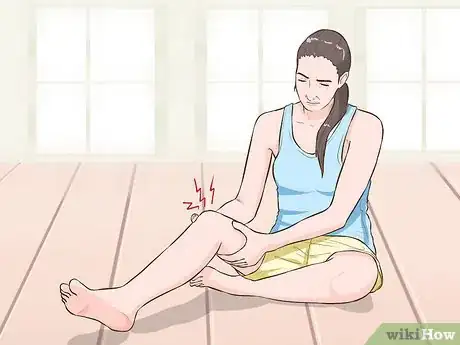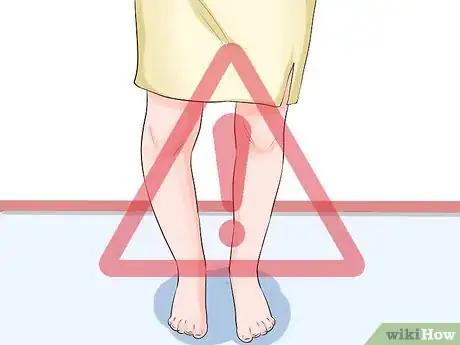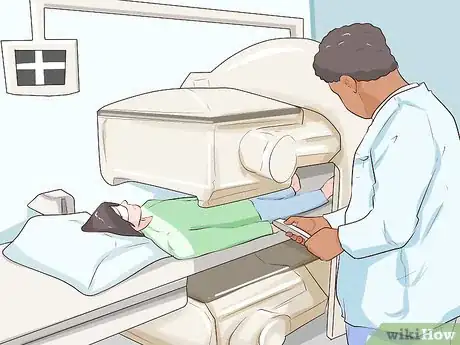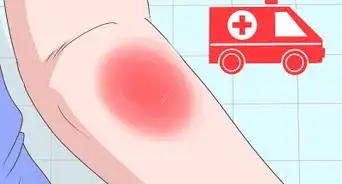This article was medically reviewed by Janice Litza, MD. Dr. Litza is a board certified Family Medicine Physician in Wisconsin. She is a practicing Physician and taught as a Clinical Professor for 13 years, after receiving her MD from the University of Wisconsin-Madison School of Medicine and Public Health in 1998.
There are 7 references cited in this article, which can be found at the bottom of the page.
This article has been viewed 15,913 times.
Paget's disease is a rare bone disease in which your bones regenerate quicker as you age, instead of slower. It is normal for new bone tissue to replace old bone tissue over time. However, the accelerated regeneration results in the thickening and weakening of bones, instead of solid regrowth. While this condition is usually spotted by a physician in an x-ray done for another condition, there are symptoms that you can spot that are associated with the condition.[1]
Steps
Identifying the Signs of Paget's Disease
-
1Assess pain in your joints and bones. While Paget's disease may have no symptoms at first onset, many with the disease do have a history of joint or bone pain. If you have painful bones or joints, especially in the pelvis, skull, spine, or legs, it could be a symptom of Paget's disease.[2]
- However, there are many causes of painful joints, including arthritis and wear and tear on the joint. Discuss any joint pain you have with your doctor and have them assess your situation.
-
2Identify additional symptoms. If you have pain in your joints and bones you should assess whether you have other symptoms associated with Paget's disease. These additional symptoms include:[3]
- Headaches
- Hearing loss
- Bones changing shape
- Tingling or numbness
Advertisement -
3Assess your risk factors. There are some factors that can increase your likelihood of getting Paget's disease. Most importantly, it usually only affects people older than 40 years old and it can be hereditary. This means that if a family member has it, you are more likely to have it as well. Also, it does affect slightly more men than women.[4]
- Remember that overall this is a very rare disease. Just because you have some risk factors and you have joint pain that does not mean you have Paget's disease.
Getting a Medical Diagnosis
-
1Make an appointment with your doctor. If you suspect that there is a problem with your bones, then you should schedule a medical exam. Your doctor will discuss your symptoms with you and get a full medical history from you.[5]
- When calling to make an appointment, tell the person on the phone "I have been having pain in my joints and bones and I am concerned that I may have Paget's disease. There is a history of this condition in my family. Could you please tell the doctor about my concern?" This will allow the doctor to do some research on the condition before you come in.
- The doctor is also likely to give you a physical exam that focuses on identifying areas of pain and discomfort.
-
2Have a set of x-rays done. If the doctor suspects Paget's disease or some other issue with your bones, they may do an x-ray. An x-ray will allow them to get a look at the structure of the bones and may allow them to identify areas that have potential problems.[6]
- The x-rays may be done in your doctor's office or you may need to go to a different medical office to have them done.
-
3Get a bone scan. If your doctor suspects that you have a problem with your bones but needs more information than an x-ray can provide, then they may recommend that you undergo a bone scan. This is a radiological procedure used to identify any areas of physical or chemical change in the bones. With a bone scan the doctor should be able to see any areas of weakness or overgrowth that could be associated with Paget's disease.[7]
- Once the bone scan is done, your doctor should discuss the results of the bone scan with you.
-
4Take a blood test. People with Paget's Disease have elevated levels of an enzyme called serum alkaline phosphatase (SAP) in their blood. Your doctor may draw your blood and send it to a lab to test for this.[8] Your doctor may also do a complete blood count, a comprehensive metabolic panel to test calcium levels and liver health, or a Vitamin D test.
Treating Paget's Disease
-
1Take bisphosphonates. In most cases of Paget's disease, bisphosphonates will be prescribed. These are medications commonly used for treating osteoporosis, as they are used to strengthen bones. With Paget's disease, they can help strengthen bones that have weakness due to improper regeneration.[9]
- Bisphosphonates used to treat Paget's disease include: Alendronate (Fosamax), Ibandronate (Boniva), Pamidronate (Aredia), Risedronate (Actonel), and Zoledronic acid (Zometa, Reclast).
-
2Consider surgery. In some cases, surgery may also be recommended to fix fractures that have healed incorrectly or to realign poorly formed bones. This is an extreme treatment for Paget's disease and may not be necessary for all those afflicted.[10]
- Discuss the option of surgery with your doctor. If they do not have enough experience with the disease, you may need to consult with a specialist to assess whether surgery is right for you.
-
3Manage the condition. In addition to medical treatment, there are some things you can do at home to help keep Paget's disease under control. These things include preventing falls, increasing your exercise, and controlling your diet.[11]
- Preventing falls requires that you eliminate risky behaviors and activities. Sports that often cause injury, such as American football, should be avoided. If all risky activities cannot be completely avoided, you should at least wear all of the appropriate protective clothing, such as knee pads, to prevent injury.
- While you want to make sure you don't injure yourself, it is important to continue, or begin, exercising. Exercising helps to strengthen muscles and bones, which can help to stave off the negative side effects of Paget's disease. Do exercises that do not have a large risk of injury to the bones, including gentle stretching and non-impact exercises like swimming.
- Also, it's important to maintain a healthy diet. A good diet for Paget's disease includes foods that are high in calcium and vitamin D. These nutrients are essential for bone health and strength, and can be taken as supplements if you cannot incorporate enough of them into your diet.
References
- ↑ http://www.rheumatology.org/I-Am-A/Patient-Caregiver/Diseases-Conditions/Pagets-Disease-of-Bone
- ↑ https://www.nhs.uk/conditions/pagets-disease-bone/
- ↑ https://www.nhs.uk/conditions/pagets-disease-bone/
- ↑ https://rarediseases.org/rare-diseases/pagets-disease/
- ↑ https://orthoinfo.aaos.org/en/diseases--conditions/pagets-disease-of-bone/
- ↑ https://www.nhs.uk/conditions/pagets-disease-bone/diagnosis/
- ↑ https://www.bones.nih.gov/health-info/bone/pagets/diagnosed
- ↑ https://www.bones.nih.gov/health-info/bone/pagets/diagnosed
- ↑ https://www.aafp.org/afp/2002/0515/p2069.html



































































Medical Disclaimer
The content of this article is not intended to be a substitute for professional medical advice, examination, diagnosis, or treatment. You should always contact your doctor or other qualified healthcare professional before starting, changing, or stopping any kind of health treatment.
Read More...